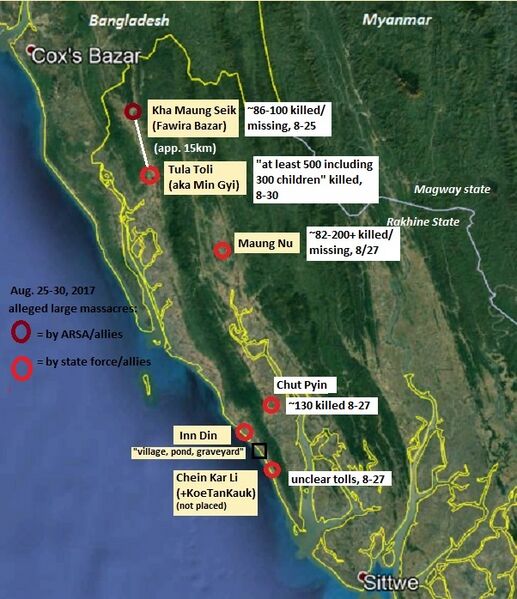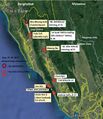File:Myanmar massacres map.jpg
Jump to navigation
Jump to search


Size of this preview: 517 × 599 pixels. Other resolutions: 207 × 240 pixels | 602 × 698 pixels.
Original file (602 × 698 pixels, file size: 172 KB, MIME type: image/jpeg)
Details/Sources
(should and might be moved to a dedicated page or two...)
- Kha Maung Seik: Many sources, forthcoming... approximately 90 Hindu civilians, including women and children, executed on August 25. 18 women and children spared, because the 8 women were pretty and single, made to convert, married some Muslims who had them tell a story to the media. see Monitor on Massacre Marketing data dump for most available info (by links if not citation). This incident has not been called out as a crime or even an event by either HRW or AI. HRW addresses the claims, but only as government accusations that clash with the stories they are looking into, and constitute the Myanmar government "playing politics with the dead." They do call for justice if a credible investigation finds ARSA militants guilty, but reason that this is unlikely to happen.
- Tula Toli: ACLOS page The Guardian reports on U.S. Holocaust museum study citing this as one of three most prominent massacres. "Myanmar soldiers are accused of slaughtering hundreds of Rohingya, including children, who were gathered on a river bank, and then burning the bodies. “Some small children were thrown into the river,” said a witness quoted in the report. “They hacked small children who were half-alive.” Women were herded into huts, raped, beaten to death (or unconscious) and the huts were burned. - Human Rights Watch report on this massacre - Amnesty International report lists this as one of five prominent massacres, and one of the two deadliest. Listed as Min Gyi (an alternate name - see Wikimapia - location: 16 km south of Kha Maung Seik, 30 km nw of Maung Nu) - Wikipedia article cites an alleged death toll of at least 500, including 300 children.
- Maung Nu: ACLOS page - Human Rights Watch report on this massacre couldn't verify a death toll, but says it's "dozens." - The Guardian reports on U.S. Holocaust museum study citing this as one of three most prominent massacres. "At least 150 men and boys from Maung Nu village, Buthidaung township, were shot dead after sheltering in the house of a local leader, survivors told Fortify Rights." - AP report "at least 82" killed. AP report "Shafir Rahman, 50, says he will never forget seeing one of the slaughter's first, horrific moments: a soldier hammering a four-inch nail into the side of a man's head with a rifle butt." ""I don't know where they took [the bodies]," he says. "I just saw what was left. There was blood everywhere.""
- Chut Pyin: Independent, Sept. 1 Fortify Rights reports a massacre of around 130, with some bodies burned in pits in the sand. ["So far reports — I think quite credible — mention about 130 people including women and children killed," Chris Lewa, director of The Arakan Project which works with Rohingya communities, said. ABC reports] ""So far reports — I think quite credible — mention about 130 people including women and children killed," Chris Lewa, director of The Arakan Project which works with Rohingya communities, said." ABC saw a video of the village burning, and of "mounds of freshly dug earth — allegedly the graves of those killed. "This is where the dead bodies from Chut Pyin village were buried … they buried 10-20 bodies, putting two to three bodies in each pit," an unidentified man on the video said. The graves were allegedly dug on Sunday night in the village of Ah Htet Nan Yar, south of Chut Pyin, with more bodies burned by security forces." The Guardian reports on U.S. Holocaust museum study citing this as one of three most prominent massacres. "In Rathedaung township’s Chut Pyin village, soldiers and armed civilians allegedly herded men and boys into a hut before setting it on fire." Amnesty International report lists this as one of five prominent massacres, and one of the two deadliest.
- Inn Din: Location: south coastal areaWikimapia - Amnesty International report lists this as one of five prominent massacres. - NYT report, Dec. 19 says two arrested journalists had obtained photos from here. "Senior Gen. Min Aung Hlaing, the commander in chief in Myanmar, said that the military was carrying out an investigation into unidentified “people being killed and buried” in a cemetery in Inn Din. “Strong legal action will be taken if any member of security forces are involved,” the Facebook post said." Five ethnic Rakine locals (possible Rohingya opponents) were arrested for supplying the photos. It's not clear what they showed. - It was only on or just before Dec. 18 the bodies were found Reuters, Dec. 18 - A tweet from Dec. 20 has a photo of several men kneeling, others holding guns behind them, with labels (names?) attached. "These 10 #Rohingya were arrested on 31st August 2017 in #InnDin beach #Maungdaw South and were killed. The mass grave was found at #InnDin Buddhist cemetery on December 19th." (could line up with the 18th in US). Why the photo(s) only emerged at the same time - in the hands of this twitter user and being handed to journalists - remains unclear and interesting.
- Inn Din with the unusual photos makes history as the first massacre Myanmar security forces admit to. AFP reports (via Frontier Myanmar) a story quite different from the one told in the other cases:
- "Security forces took part in a massacre of 10 Rohingya in September, the army chief's office said late Wednesday, as it admitted for the first time abuses during a crackdown that sparked a mass exodus of the Muslim minority. The massacre took place on September 2 at the village of Inn Din in Maungdaw Township, the Facebook post said, as tensions escalated pitting Rohingya against security forces and ethnic Rakhine locals following the killing of a Rakhine man. "Some villagers from Inn Din village and security members confessed they killed 10 Bengali terrorists," the office said in its post, using a pejorative term for Rohingya and blaming militants for causing the unrest in the village."
- By the content of government statements so far, these people should now be charged and punished, which is likely.
- Monitor on Massacre marketing: An Admission at Inn Din: Precedent for What? - compares this to other massacre stories, and different versions of this same story to each other. "Strangely, even as the government side admits to the killings, the opposition's story appears to be poorly-managed fiction like their others. Maybe it's just reflexive, or maybe they're just trying to hide the fact that these were militants, but alleged witnesses keep changing the story for some reason." Notably how the victims were shot and who buried them has changed. An early version given to Amnesty International has the Buddhist killers shooting people as they ran and leaving the bodies for relatives to bury, in a cemetery. As the story grew with photos of captive men awaiting execution, the survivors started saying the men were arrested and then killed, and buried by the killers rather than their own kin. Separately, how they were arrested has been reported with two different versions.
- Two smaller massacres near Inn Din, with somewhat similar stories - both covered in some detail in October Amnesty report:
- Chein Kar Li - Amnesty International report lists this as one of five prominent massacres, on 27 August. Location: coastal, south of Inn Din (Wikimapia)
- Koe Tan Kauk - Amnesty International report lists this as one of five prominent massacres, on 27 August. "Chein Kar Li and Koe Tan Kauk, two neighbouring villages" (location not found, but should be near the above)
File history
Click on a date/time to view the file as it appeared at that time.
| Date/Time | Thumbnail | Dimensions | User | Comment | |
|---|---|---|---|---|---|
| current | 09:42, 25 December 2017 |  | 602 × 698 (172 KB) | Caustic Logic (talk | contribs) | Category:MyanmarCategory:MassacresCategory:Maps |
You cannot overwrite this file.
File usage
There are no pages that use this file.